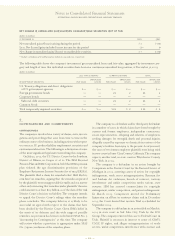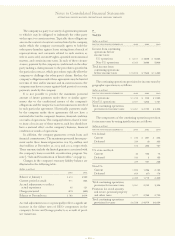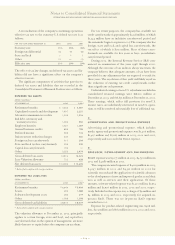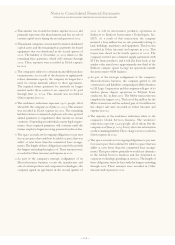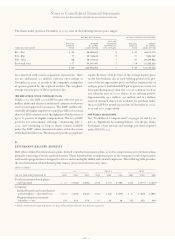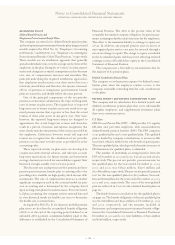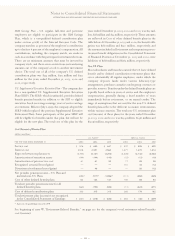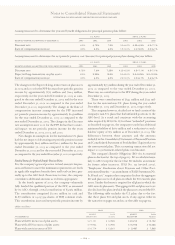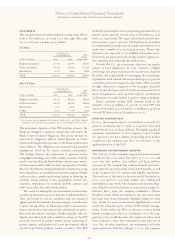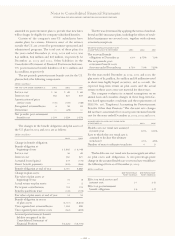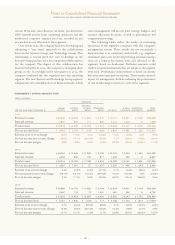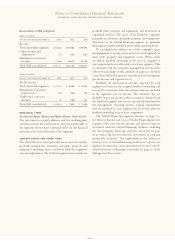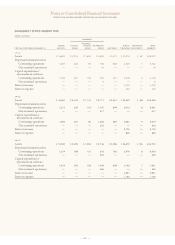IBM 2003 Annual Report Download - page 113
Download and view the complete annual report
Please find page 113 of the 2003 IBM annual report below. You can navigate through the pages in the report by either clicking on the pages listed below, or by using the keyword search tool below to find specific information within the annual report.
111
Notes to Consolidated Financial Statements
INTERNATIONAL BUSINESS MACHINES CORPORATION AND SUBSIDIARY COMPANIES
ACCOUNTING POLICY
Defined Benefit Pension and
Nonpension Postretirement Benefit Plans
The company accounts for its defined benefit pension plans
and its nonpension postretirement benefit plans using actuarial
models required by SFAS No. 87, “Employers’ Accounting
for Pensions,” and SFAS No. 106, “Employers’ Accounting for
Postretirement Benefits Other Than Pensions,” respectively.
These models use an attribution approach that generally
spreads individual events over the average service lives of the
employees in the plan. Examples of “events” are plan amend-
ments and changes in actuarial assumptions such as discount
rate, rate of compensation increases and mortality. The
principle underlying the required attribution approach is
that employees render service over their service lives on a
relatively smooth basis and therefore, the income statement
effects of pensions or nonpension postretirement benefit
plans are earned in, and should follow, the same pattern.
One of the principal components of the net periodic
pension cost/(income) calculation is the expected long-term
rates of return on plan assets. The required use of expected
long-term rate of return on plan assets may result in recog-
nized pension income that is greater or less than the actual
returns of those plan assets in any given year. Over time,
however, the expected long-term returns are designed to
approximate the actual long-term returns and therefore
result in a pattern of income and expense recognition that
more closely matches the pattern of the services provided by
the employees. Differences between actual and expected
returns are recognized in the calculation of net periodic
pension cost/(income) over five years as provided for in the
accounting rules.
These expected returns on plan assets are developed in
conjunction with external advisors, and take into account
long-term expectations for future returns and investment
strategy. Amounts are tested for reasonableness against their
historical averages, usually over a ten year period.
The discount rate assumptions used for pension and non-
pension postretirement benefit plan accounting reflect the
prevailing rates available on high-quality, fixed-income debt
instruments. The rate of compensation increase is another
significant assumption used in the actuarial model for pen-
sion accounting and is determined by the company, based
upon its long-term plans for such increases. For retiree med-
ical plan accounting, the company reviews external data and
its own historical trends for health care costs to determine
the health care cost trend rates.
As required by SFAS No. 87, for instances in which pension
plan assets are less than the accumulated benefit obligation
(ABO) as of the end of the reporting period (defined as an
unfunded ABO position), a minimum liability equal to this
difference is established in the Consolidated Statement of
Financial Position. The ABO is the present value of the
actuarially determined company obligation for pension pay-
ments assuming no further salary increases for the employees.
The offset to the minimum liability is a charge to equity, net
of tax. In addition, any prepaid pension asset in excess of
unrecognized prior service cost must be reversed through a
net-of-tax charge to equity. The charge to equity is included
in the Accumulated gains and (losses) not affecting retained
earnings section of Stockholders’ equity in the Consolidated
Statement of Financial Position.
The company uses a December 31 measurement date for
the majority of its pension plans.
Defined Contribution Pension Plans
The company records pension expense for defined contri-
bution plans when the employee renders service to the
company, essentially coinciding with the cash contributions
to the plans.
DEFINED BENEFIT AND DEFINED CONTRIBUTION PLANS
The company and its subsidiaries have defined benefit and
defined contribution pension plans that cover substantially
all regular employees, and supplemental retirement plans
that cover certain executives.
U.S. Plans
IBM Personal Pension Plan (PPP) – IBM provides U.S. regular,
full-time and part-time employees with noncontributory
defined benefit pension benefits (PPP). The PPP comprises
a tax qualified plan and a non-qualified plan. The qualified
plan is funded by company contributions to an irrevocable
trust fund, which is held for the sole benefit of participants.
The non-qualified plan, which provides benefits in excess of
IRS limitations for qualified plans, is unfunded.
The number of individuals receiving benefits from the
PPP at December 31, 2003 and 2002, was 136,302 and 136,365,
respectively. The pre-tax net periodic pension income for
the qualified plan for the years ended December 31, 2003,
2002 and 2001, was $(692) million, $(917) million and
$(1,086) million, respectively. The pre-tax net periodic pension
cost for the non-qualified plan was $107 million, $106 mil-
lion and $118 million for the years ended December 31, 2003,
2002 and 2001, respectively. The costs of the non-qualified
plan are reflected in Cost of other defined benefit plans on
page 112.
The funded status reconciliation for the qualified plan is
on page 113. The benefit obligation of the non-qualified plan
was $1,068 million and $940 million at December 31, 2003
and 2002, respectively, and the amounts included in
Retirement and nonpension postretirement benefit obliga-
tions in the Consolidated Statement of Financial Position at
December 31, 2003 and 2002, were liabilities of $901 million
and $798 million, respectively.


